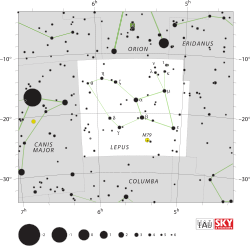Beta Leporis

| |
| Observation data Epoch J2000.0 Equinox J2000.0 (ICRS) | |
|---|---|
| Constellation | Lepus |
| Right ascension | 05h 28m 14.72316s[1] |
| Declination | −20° 45′ 33.9878″[1] |
| Apparent magnitude (V) | 2.84[2] |
| Characteristics | |
| Spectral type | G5 II[3] |
| U−B color index | +0.47[2] |
| B−V color index | +0.82[2] |
| R−I color index | +0.44[4] |
| Astrometry | |
| Radial velocity (Rv) | −13.6 ± 0.9[5] km/s |
| Proper motion (μ) | RA: −5.02[1] mas/yr Dec.: −85.92[1] mas/yr |
| Parallax (π) | 20.34 ± 0.18[1] mas |
| Distance | 160 ± 1 ly (49.2 ± 0.4 pc) |
| Details | |
| Mass | 3.5 ± 0.1[6] M☉ |
| Radius | 16[7] R☉ |
| Luminosity | 171[8] L☉ |
| Surface gravity (log g) | 2.60 ± 0.03[6] cgs |
| Temperature | 5,450 ± 100[6] K |
| Metallicity [Fe/H] | +0.05[9] dex |
| Rotational velocity (v sin i) | 11[10] km/s |
| Age | 240[6] Myr |
| Other designations | |
| Database references | |
| SIMBAD | data |
Beta Leporis (β Leporis, abbreviated Beta Lep, β Lep), also named Nihal,[11] is the second brightest star in the constellation of Lepus.[7]
Nomenclature
Beta Leporis is the star's Bayer designation. It is also known by the traditional named Nihal, Arabic for "quenching their thirst". The occasional spelling Nibal appears to be due to a misreading.[12] In 2016, the International Astronomical Union organized a Working Group on Star Names (WGSN)[13] to catalog and standardize proper names for stars. The WGSN's first bulletin of July 2016[14] included a table of the first two batches of names approved by the WGSN; which included Nihal for this star.
Properties
Based on parallax measurements from the Hipparcos astrometry satellite,[15] this star is located about 160 light-years (49 parsecs) from the Earth. It has an apparent visual magnitude of 2.84 and a stellar classification of G5 II. The mass of this star is 3.5 times the mass of the Sun and it is about 240 million years old,[6] which is sufficient time for a star this massive to consume the hydrogen at its core and evolve away from the main sequence, becoming a G-type bright giant.[3]
This is a double star system and may be a binary. Using adaptive optics on the AEOS telescope at Haleakala Observatory, the pair was found to be separated by an angle of 2.58 arcseconds at a position angle of 1.4°.[16] Component B has been observed to fluctuate in brightness and is catalogued as suspected variable star NSV 2008. [17]
References
- 1 2 3 4 5 van Leeuwen, F. (November 2007). "Validation of the new Hipparcos reduction". Astronomy and Astrophysics. 474 (2): 653–664. arXiv:0708.1752
 . Bibcode:2007A&A...474..653V. doi:10.1051/0004-6361:20078357.
. Bibcode:2007A&A...474..653V. doi:10.1051/0004-6361:20078357. - 1 2 3 Johnson, H. L.; et al. (1966). "UBVRIJKL photometry of the bright stars". Communications of the Lunar and Planetary Laboratory. 4 (99). Bibcode:1966CoLPL...4...99J.
- 1 2 3 "CCDM J05283-2046AB -- Double or multiple star", SIMBAD, Centre de Données astronomiques de Strasbourg, retrieved 2011-12-27
- ↑ HR 1829, database entry, The Bright Star Catalogue, 5th Revised Ed. (Preliminary Version), D. Hoffleit and W. H. Warren, Jr., CDS ID V/50. Accessed on line November 18, 2008.
- ↑ Evans, D. S., "The Revision of the General Catalogue of Radial Velocities", in Batten, Alan Henry; Heard, John Frederick, Determination of Radial Velocities and their Applications, Proceedings from IAU Symposium no. 30 held at the University of Toronto 20-24 June, 1966, Academic Press, London, p. 57, Bibcode:1967IAUS...30...57E
- 1 2 3 4 5 Lyubimkov, Leonid S.; et al. (February 2010), "Accurate fundamental parameters for A-, F- and G-type Supergiants in the solar neighbourhood", Monthly Notices of the Royal Astronomical Society, 402 (2): 1369–1379, arXiv:0911.1335
 , Bibcode:2010MNRAS.402.1369L, doi:10.1111/j.1365-2966.2009.15979.x
, Bibcode:2010MNRAS.402.1369L, doi:10.1111/j.1365-2966.2009.15979.x - 1 2 Kaler, James B., "Nihal", Stars, retrieved 2008-11-18
- ↑ Mallik, Sushma V. (December 1999), "Lithium abundance and mass", Astronomy and Astrophysics, 352: 495–507, Bibcode:1999A&A...352..495M
- ↑ Luck, R. Earle; Wepfer, Gordon G. (November 1995), "Chemical Abundances for F and G Luminosity Class II Stars", Astronomical Journal, 110: 2425, Bibcode:1995AJ....110.2425L, doi:10.1086/117702
- ↑ Bernacca, P. L.; Perinotto, M. (1970). "A catalogue of stellar rotational velocities". Contributi Osservatorio Astronomico di Padova in Asiago. 239 (1). Bibcode:1970CoAsi.239....1B.
- ↑ "IAU Catalog of Star Names". Retrieved 28 July 2016.
- ↑ Allen, Richard Hinckley (1899), Star-names and Their Meanings, New York: G. E. Steichert, pp. 265, 269
- ↑ "IAU Working Group on Star Names (WGSN)". Retrieved 22 May 2016.
- ↑ "Bulletin of the IAU Working Group on Star Names, No. 1" (PDF). Retrieved 28 July 2016.
- ↑ Perryman, Michael (2010), The Making of History's Greatest Star Map, Heidelberg: Springer-Verlag, doi:10.1007/978-3-642-11602-5
- ↑ Roberts, Lewis C., Jr. (May 2011), "Astrometric and photometric measurements of binary stars with adaptive optics: observations from 2002", Monthly Notices of the Royal Astronomical Society, 413 (2): 1200–1205, arXiv:1012.3383
 , Bibcode:2011MNRAS.413.1200R, doi:10.1111/j.1365-2966.2011.18205.x
, Bibcode:2011MNRAS.413.1200R, doi:10.1111/j.1365-2966.2011.18205.x - ↑ "NSV 2008, database entry", New Catalogue of Suspected Variable Stars, the improved version, Moscow, Russia.: Sternberg Astronomical Institute, retrieved 2008-11-18